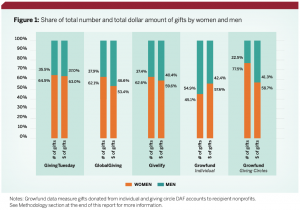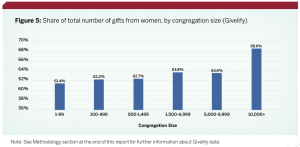New Study Shows Powerful Faith-Based Giving Trends Among Women
Given the numerous challenges, what steps can faith-based organizations take to continue receiving donations in these times of low to no parishioner turnout?
Among the first steps, faith organization leaders can take are to adopt online giving and acknowledge the significant giving trends among women in faith-based communities.
A report by Indiana University Purdue University (IUPUI) Women’s Philanthropy Institute highlights these trends in the report, womengive | 2020.
The effects of the global health crisis are more sweeping than first imagined. COVID-19 does not discriminate based on wealth, health, or age. The novel virus strikes at our physical health, mental well-being, and financial security. We recently did a nationwide study to learn how the effects of COVID-19 impact churches. Industries across the world are reeling from the negative impacts in historic monetary downturns – the airline industry reported a 95% decrease in passenger demand, the oil industry saw historic lows for crude oil – and the country’s religious sector is no exception.
Givelify was among the four organizations that supplied data to the research institute. The other companies included GivingTuesday, GlobalGiving, and GrowFund (Individual and Giving Circles). Based on the report, Givelify identified five vital takeaways faith leaders could implement today to blunt the financial impact to their offering plates.
Download the Report Now
1. Women give more gifts than men and distribute a greater percentage of dollars than men.
Inside of the 48-page report from IUPUI, consistent giving trends among women showed up in the data – women give more gifts than men.
According to the study, on average, women give 63% of the total gifts donated on the online donation platform. Additionally, women gave 58% of the total dollars donated.

While the research shows men, on average, give more substantial donations, women make smaller donations more frequently to make up a more significant proportion of the dollars.
Along with their smaller gift size, women donate to smaller charitable organizations more than men.
Global Impact’s CEO Scott Jackson explains this behavior. Jackson theorizes that women’s smaller, more frequent gifts are because they are “more proactive, plan their giving, and give consistently over time.” He continued to hypothesize that men were shown to be “reactionary givers” making one time gifts to social missions when someone asks them to give.
This knowledge of the psychological behavior between the genders may give faith organizations a beneficial tool when fundraising.
For example, organizations should consider women are more likely to donate based on schedules and plan their messages to target these donors on holidays, annual church events, and major capital campaigns.
In comparison, organizations should consider men to give financial support on one-time events. Asking for monetary donations for mission-based trips, community fundraisers, or other events that need larger gift giving.
2. Race and Gender impact donations for larger congregations.
A congregation’s size and gender can impact donation amounts, according to data by the report and Givelify’s research.
On top of the fact women donate more, women of color in predominately African American congregations with fewer than 100 people gave 61.4% of the gifts.
3. Online giving surges, but onsite giving remains necessary
More than ever, a majority of American’s turn to the internet to make charitable donations. According to IUPUI’s same research, nine in 10 adults in the U.S. use the internet. Moreover, women are slightly more inclined to use the internet than men.
The research also shows that 81% of Americans own a mobile phone, and 33% of smartphone users rely on phones for transactions, information, news, and to find resources.

As younger generations donate less via check and cash, mobile phone apps are becoming the default method of giving. However, while more congregations adopt an online giving platform, onsite donations (cash or plate offerings) are vital to building a sense of community and understanding behind the act of giving. Needless to say, faith organizations are forced to adopt new payment methods faster in order to say financially stable.
The research shows that many families take the opportunity to teach their children about giving through traditional faith organization offerings. Plus, as the report by IUPUI states, “No donor wants to be treated like an ATM or a computer screen.” Community and fellowship remain vital to parishioners to encourage and maintain a faith organization’s offerings.
4. The definition of philanthropy needs to evolve
Throughout the world, faith-based organizations are leading their congregations to understand the act of philanthropy differently on GivingTuesday – the global generosity movement.
The report shares stories from three countries, including Mexico, India, and South Africa, that evolved the philanthropic message of GivingTuesday to be more inclusive.
For example, Mexico’s religious leaders emphasize the need for followers to give time and talents along with their treasures (monetary gifts) to their faith organizations.
Organizers in India use global day of giving to share messages of women’s empowerment. Specifically, campaigns inside of Mumbai’s public transportation promote women’s education and nonprofits that support women’s causes.
Finally, the evolution of the term philanthropy is essential because in some countries, like South Africa, the word can bring a negative connotation. The people in the southern region view the term as being only for very wealthy. The term morphed into the concept of Ubuntu, which involves informal giving within one’s family and community.
5. Technology will aid in multi-faith organization giving from individual donors
Faith organization attendance is down across the country, and fewer people identify with a specific faith organization. In a recent survey by Gallup, 50% of American’s belong to a faith organization. That’s down nearly 20% since 1999.
Additionally, that same Gallup poll shows that 19% of American’s don’t have a religious preference, more than double reported in 2000.
One can infer that while faith organization attendance is down, it doesn’t mean American’s aren’t going to faith organizations. Instead, more congregants are dual-members in different faith organizations or attend services online.
Technology can aid in building a faith-based community outside of the sanctuary. Givelify believes that instead of striving to create a community despite online giving taking place and via smartphone apps, building a community through online giving can be achieved.
For example, church websites, mobile apps, and other technology-based solutions can help these organizations build these communities.
Church leaders are the ones to guide their followers in times of crisis; today’s demands are no different. More is required from faith leaders to navigate these unimaginable times.
Despite these difficult challenges, faith organization leaders can apply the insights shown in the womengive | 2020 report to maintain and, potentially, increase donations in times of change.
The Top 5 Vital Facts about Women and Online Giving
- Women give more gifts than men and distribute a higher percentage of dollars than men.
- Color and Gender impact donations for larger congregations.
- Online giving surges, but onsite giving remains necessary.
- The definition of philanthropy needs to evolve.
- Technology will aid in multi-faith organization giving from individual donees.
How do you see online giving and gifts from women impacting the future of faith-based organizations? Will the same remain true after this historic pandemic? We’ve seen this trend since 2017 and we think it will remain!



